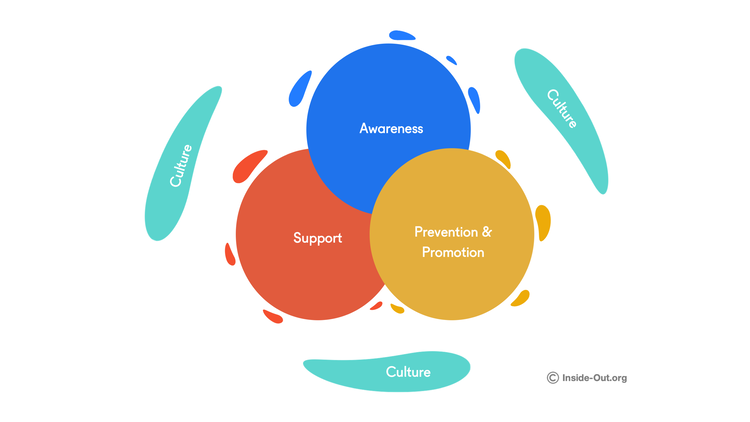19 Aug Written By Rob Stephenson
A Stern Word
The other day, my #wife had a stern word with me. As is often the case, it involved my tardiness in relation to taking the bins out. After proudly dealing with the food waste; the recycling and the general waste, I thought that I was off the hook. But no, Mary was not finished in the stern word department.
“You don’t do enough thought leadership, young man!”
Mary then delivered some thoughtful guidance on my personal brand and offered a view that I might spend a little too much time talking about my hair these days. Whilst not fully agreeing with the sentiment, I concede that she may have a point. So here I am, pen in hand and using my first 130 words to witter on about nothing in particular.
Mental Health – is this one of the great leadership challenges of our time?
“If you haven’t embraced the mental health and wellbeing agenda by now then you should question if you truly are a leader.”
These were the words of John Flint, Former Group CEO, HSBC – speaking at the G24 Mental Health Summit in May. Mental health was one of the challenges of our time before the pandemic. Investing time and resource in caring for the mental wellbeing of employees is now not optional. Leaders who ignore this will find that their employer brand will be damaged beyond repair as people will remember how you made them feel during these times.
Some organisations may be late to the party but even the most enlightened and forward-thinking employers are still only in the foothills of where we need to be. It is encouraging to see that many companies are looking to invest resources in creating culture where the wellbeing of their people is prioritised. The rest of this piece will explore some ideas on what good looks like.
An integrated mental health and wellbeing strategy

An integrated mental health and wellbeing strategy is much more than the Headspace App and Mental Health First Aid. All too often we see organisations introduce the elements of an integrated strategy in a linear fashion. It goes a bit like this:
1. Mental Health Awareness – We must get people feeling comfortable about talking about mental health, so let’s get Geoff McDonald or Rob Stephenson in to share their stories. (other brands of inspirational mental health speaker are available!).
2. Mental health support – Hold on, if we are opening the can of worms then we must have some support in place so let’s make sure that we invest in an EAP (Employee Assistance Programme) or train up some mental health first aiders.
3. Prevention – Then, 2 years down the line, we realise that we are only engaging with a small proportion of our people so we must look at “prevention” and we have no idea what to do here so let’s get everyone a Headspace App and see what happens.
I am not knocking it. If employers do all of these then they are well on the way to realising the fantastic performance gains that come from having a workforce that is closer to the thriving end of the mental health continuum.

However, this process is inefficient at best and if we do not undergo a cultural transformation along the way then we will not maximise the opportunity we have. Let’s explore each of the elements in turn.
Mental health awareness
We cannot properly explore awareness unless we address the elephant in the room – mental health has a brand problem. We often still think of mental health as a binary state of affairs: you are either mentally well (most of us) or mentally ill (those unlucky folks who have depression and anxiety or a more serious condition). This thinking needs to be taken outside with the rest of the rubbish referred to in earlier ramblings. It is not black and white. We all have mental health. It is one of the most beautiful things about being human.
If we accept that we all have mental health then we can accept that we are all able to influence it, just like out physical health and fitness. This has to be the starting point for any awareness strategy if an organisation wants to engage with the majority of employees.
“We need to create awareness of positive mental health as well as mental ill-health”
Positive mental wellbeing awareness
There are a number of models that can be used to do this. Personally, I have evolved the 5 ways to wellbeing into a framework that resonates very well with people. I also find it helpful to “rebrand” mental health and use the word “Form”. This has the effect of making people feel at ease discussing their mental wellbeing in a non-threatening way.
These drivers of form (or mental wellbeing) apply to everyone in the workplace and drive the basis of positive mental health if managed proactively. It is beyond the scope of this piece to explore each of these in detail, but a good awareness programme will look to address all of these elements and impart literacy to employees in how to manage them. This is an important aspect because we are typically not taught mental hygiene as we are growing up in the way that we are taught dental or personal hygiene (in most cases). Traditionally, we only gain this literacy if we have needed to in order to recover from a mental health challenge or condition.
Mental ill-health awareness
This is the typical awareness raising that we associate with mental health. Anxiety and depression are not the only challenges. Smashing the stigma so that “it is ok to not be OK’; to “bring your whole self to work” or to put you hand up and say that you are struggling with mental ill-health and need some help. This is important. It is morally the right thing to do and essential during the times of the pandemic as 100% of us will know what it is like to struggle with our mental health to one degree or another as a result of lockdown. In the UK we have seen some fantastic work on this front during the last 5 years and particularly since 2017 when Princes Harry and William shared their stories.
Mental Health Awareness can be raised in many ways:
- Speakers: external speakers with lived experience of mental ill-health, sharing their journey through to recovery
- Storytelling: employees with lived experience sharing their stories via blog posts; videos or at events
- Mental Health Awareness Training: Specific mental health awareness training or mental health first aid training
- Awareness Days: World Mental Health Day in October; Mental Health Awareness Week in the UK and Month in the US in May. These are great to plan events around but a word of caution in that it is not enough to generate awareness twice a year with nothing in between
- External campaigns: This is me; the green ribbon campaign are two very good examples.
There are lot that you can do as an organisation here. My advice here is to look to do something each month.
Mental health support

OK, once we get people to open up and talk about their mental health, we need to be able to support them on their journey towards thriving. Mental health support can take many forms and range from corporate wellbeing programmes and mental health resources to peer support networks. A number of ideas are listed below but it is important that employers also create a culture of permission where employees feel empowered to utilise the solutions.
- Employee Assistance Programme (EAP): an employee benefits programme that offers support for people who are struggling with their mental health. Typically, these will include telephone support lines and counselling services. Cost effective but engagement rates tend to be quite low. Top Tip: renaming an EAP to something like “Personal Support Service” can significantly boost engagement.
- In-House Counsellors or Mental Health Nurses: An excellent solution if the business can afford it. The Bank of England has provided in-house therapists to staff for over 30 years.
- Peer Support Networks: Internal network dedicated to mental health and wellbeing where people can connect with others wo might be experiencing a challenge or who have an interest in the agenda. Often hosted on an intranet or internal social channel.
- Mental Health Champions/Advocates and Mental Health First Aid: Individuals who have been trained up to be available to talk to those who might be struggling. Appropriate boundaries; signposting to clinical solutions and support of the champion and first aider are all important here.
- Line Manager Training: An important element of support is equipping line managers to have conversations about mental health in teams as often this will be where first contact will occur.
- Other mental health resources can be offered under support. Wellness Action Plans are another great example of a simple solution that can have a very positive effect.
- Digital Mental Health Platforms:There is a whole range of digital solutions available across support from virtual primary care; online therapy and content driven solutions. They are cost effective and scalable?
How are you today?
As part of supporting employees effectively, employers must check in with them. This is particularly the case as we travel through the pandemic and back into the physical workspace when their psychological safety will be potential under assault. The FormScore provides a simple methodology and language to help answer the question “how are you today?”. Whatever method you use to check in, it is critical that you do so right now.
Prevention and Promotion
Heads up, this is commonly known simply as “prevention”. Herein lies another problem. We are too quick to frame the mental health and wellbeing challenge in the negative. What talk about preventing people falling into distress or illness when we could be talking about the promotion of positive mental health and wellbeing.

Either way it is important that employers provide education, benefits and resources to help employees proactively manage their wellbeing.
Mental Health Education: Crossing over with awareness it is important for organisations to equip people with the knowledge on how to proactively manage their wellbeing. A degree of individual accountability is required in order to implement this knowledge, but the most enlightened employers embrace the need to impart it.
Corporate Wellbeing Programmes: there is a whole range of benefits that fall into the promotion or prevention category, from Headspace to gym memberships. The challenge for the buyer of services here is that wellbeing solutions are highly personal and individual. The emergence of marketplace style solutions such as BetterSpace will help with this issue. The most forward-thinking organisations are looking at individual wellbeing budgets with personalisation and choice.
Mental Health Resources: There are a whole host resources that can help with prevention including a well thought out mental health policy and toolkits for line managers and HR professionals.
Culture and Leadership
They say that culture eats strategy for breakfast. This is very true in the context of mental health and wellbeing as an organisation can have the best mental health strategy and suite of mental health benefits in the world but if employees do not feel empowered to use them then then you might as well throw the money down the drain. Our work on the InsideOut LeaderBoard has given is a fantastic insight into what happens when an employer gets the culture right and employees are empowered to prioritise their own wellbeing. Deloitte UK estimate ROIs of 5:1 + and there is a real opportunity to see huge productivity gains. Here are a few tips to help create a mentally health culture:
- Make the mental health and wellbeing of employees a strategic priority
- Measure the wellbeing of your organisation
- Have a mental health plan and communicate it strongly and frequently
- Report on the effectiveness of your mental health and wellbeing initiatives
- Lead with openness; honesty; vulnerability and authenticity
- Share your stories of mental ill-health
- Role model healthy behaviours
- Celebrate those who integrate work and home in a healthy way
- Don’t reward the behaviour of the high performing bad apples
- Think about a measure of organisational success that is linked to the health and happiness of employees.
Concluding thoughts
This is not an exhaustive guide, yet I used more words than intended. I hope this helps your organisation to get on the path to better organisational mental health or travel further down it. Can you afford to ignore this right now?
If you need help with any of the above and inspiring the leadership team to get on board then I would be delighted to help you. In the meantime it looks like the bins are overflowing again so duty calls..
Rob Stephenson is a mental health campaigner; SLT advisor and keynote speaker. He lives and works with bipolar disorder. Rob is the Founder of InsideOut which publishes the InsideOut LeaderBoard and runs the InsideOut Charter. He is the CEO of FormScore, a movement and technology start up helping individuals and organisations answer the question “How are you today?”


